
Far too often, patients assume that the only way to straighten crooked teeth or realign a bite is with metal brackets and wires. While this remains an option for patients of all ages, most adults who require orthodontics prefer a more subtle solution. At Jacksonville Dental Specialists, our team of experts is pleased to provide Invisalign in Jacksonville. With clear plastic aligners that are customized to fit your smile, you can feel more confident in your daily appearance and avoid the embarrassment of shiny metal. Call us today to find out if you’re a good candidate for Invisalign treatment.
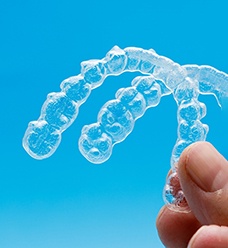
Made of clear plastic trays, Invisalign is worn 20-22 hours each day and applies gentle pressure to your teeth to shift them in the right direction. Every two weeks, you are required to swap out your existing trays for the next set. This will ensure that your teeth continue to move accordingly. Every few weeks, you’ll return to our office for a follow-up appointment so that we can check your progress.
When worn correctly, you will notice a dramatic change in your bite and teeth alignment within 12-18 months (on average).
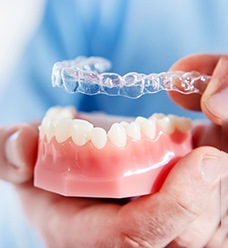
Not everyone needs Invisalign or is considered a good candidate for treatment. However, after a thorough consultation with our team, we will determine if these clear aligners can help to treat one or more of the following problems:
When teeth erupt through the gumline, there should be just enough space to ensure that you can adequately brush and floss your teeth. If teeth sit too close together, decay, cavities, and gum disease can cause a serious problem. Fortunately, Invisalign can work to gently move teeth away from each other so that overcrowding is no longer a problem.
Having too much space between teeth can be an equally serious problem that can result in food debris becoming trapped and bad bacteria accumulating. Gum disease and cavities can also develop as a result. With Invisalign, though, your teeth can shift closer together so that the space is eliminated, and your smile is more aesthetically pleasing.
When your bite is out of alignment, you’ll likely notice a problem with jaw pain and worn tooth enamel. If allowed to continue, you can face significant issues such as sensitivity and TMJ. With Invisalign, we can work to bring your overbite, crossbite, open bite, or underbite back into alignment so that your mouth works correctly moving forward.
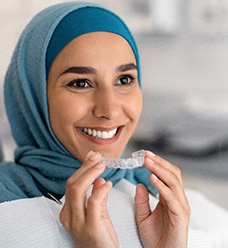
Not everyone needs Invisalign or is considered a good candidate for treatment. However, after a thorough consultation with our team, we will determine if these clear aligners can help to treat one or more of the following problems:
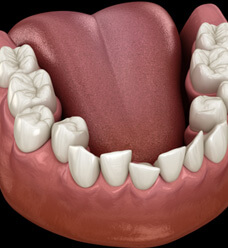
When teeth erupt through the gumline, there should be just enough space to ensure that you can adequately brush and floss your teeth. If teeth sit too close together, decay, cavities, and gum disease can cause a serious problem. Fortunately, Invisalign can work to gently move teeth away from each other so that overcrowding is no longer a problem.
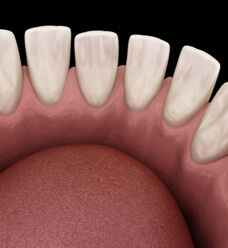
Having too much space between teeth can be an equally serious problem that can result in food debris becoming trapped and bad bacteria accumulating. Gum disease and cavities can also develop as a result. With Invisalign, though, your teeth can shift closer together so that the space is eliminated, and your smile is more aesthetically pleasing.

An overbite is when the upper row of teeth sticks out farther from the lower set of teeth, causing a bite imbalance. While the upper row being more forward than the lower row is completely natural, having an overly large gap between where these two arches meet can lead to jaw pain, speech problems, and uneven wear and tear on the teeth. Invisalign can help bring your two arches into alignment to prevent issues associated with overbite from developing.
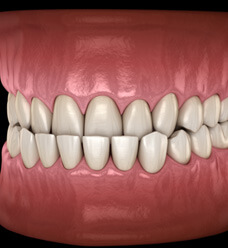
Underbite is the opposite of overbite. It’s caused when the lower row of teeth juts out in front of the top set when you close your mouth. Typically, underbites are caused by jaw injuries, genetics, and non-nutritive habits as a child, like thumb-sucking. Invisalign aligners, typically paired with elastics, can help correct underbite in adults, gradually realigning the bottom jaw with the upper.
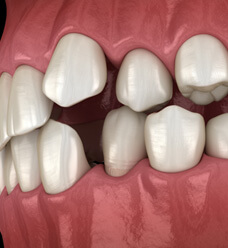
There are two types of crossbite, called front or back crossbite. This is when some of the bottom teeth rest in front of the upper ones. This is often the result of jaw development issues, but in some cases, Invisalign aligners may be able to address it to help prevent dental problems associated with this type of malocclusion from developing in the future.

Open bite is characterized by the bottom and top front teeth being unable to overlap or touch when the mouth is closed. This type of misalignment can lead to excessive wear-and-tear on the back teeth, causing dental sensitivity, increased risk of cavities, and more. Invisalign aligners can be used to shift the teeth to come together when the mouth is closed, making basic tasks like eating and speaking easier.

Although Invisalign is relatively hassle-free, you can expect there to be a slight adjustment period at the beginning of your teeth-straightening journey. After all, it takes some time to establish a good routine, to navigate brushing your teeth on the go, and to figure out the best time to schedule your check-in visits. To help, we’ve dedicated this next section to covering some information about living with Invisalign.
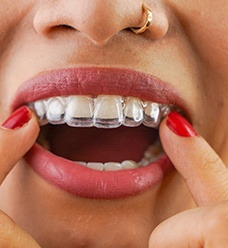
There’s an important rule with Invisalign: you need to wear your aligners for 20-22 hours a day. To make sure that happens, you need to create a good routine and stick to it. An example would be dedicating 30 minutes to each meal and using the remaining time to brush and floss. Of course, that doesn’t work for everyone. The key is using a stopwatch at the beginning of your treatment so you know how close or far you are from the mark.
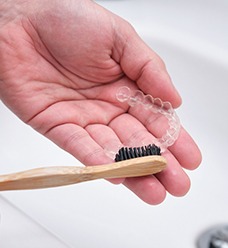
Fortunately, cleaning your aligners doesn’t require anything too cumbersome. In fact, it doesn’t even require a lot of time! All you need to do is use a soft-bristled toothbrush and clean, cool water to clean them after each meal. It’s also a good idea to get in the habit of rinsing your trays with water when you take them off so saliva, plaque, and the like don’t sit on the surface for long periods of time.

As you may already know, Invisalign doesn’t require you to alter your diet in any way. With that said, there are a few things you should keep in mind since what you eat impacts your oral health. Your intake of added sugar is a perfect example because this sweetener can wreak havoc on your teeth and, in turn, negatively affect your treatment plan. Similarly, extremely crunchy foods, like hard pretzels, can cause an attachment to come off.

Although Invisalign aligners are crafted from durable, high-quality plastic, it is possible for them to break. Sometimes, it’s from falling on the floor. Other times, it’s from clenching your teeth at night. Whatever the case may be, don’t hesitate to call us. This happens from time to time, so we won’t judge you. We just need to learn a little more about the situation, including how severe the damage is, so we can determine what the next best steps are.
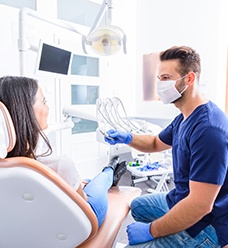
Another part of your life with Invisalign will be your routine check-in visits with our team. Don’t worry – they are usually only every 6-8 weeks. Plus, if your teeth are moving as anticipated, they take less than 20 minutes. In short, even if you are a busy student, parent, or professional, you don’t have to worry about these appointments weighing down your calendar.

Oftentimes, patients are drawn to Invisalign because of how discreet the aligners are. The reality is that this is just one of the many reasons more than 18 million patients have chosen this innovative orthodontic treatment for their smiles! If you’re currently in the process of deciding which teeth-straightening service is right for you, then read on. You’ll see just how incredible clear aligners are!

Invisalign relies on smooth plastic aligners that fit over your teeth to gently shift them into their ideal placements. Because there are no sharp edges or brittle metal like traditional braces, you don’t have to worry that your orthodontics will abrade the soft tissues inside your mouth. Although you may feel some mild aches when you switch to a new set of trays, this is typically not considered a painful treatment.

Having crooked or overcrowded teeth impacts more than just your oral health; it also can detract from your appearance. Unfortunately, many patients worry more about how they’ll be perceived when they have bulky metal brackets on their teeth. However, Invisalign is made from transparent materials so that when they’re inserted, all anyone can see is your natural teeth. You’ll be able to smile authentically without fear of judgment.

When you have braces, leftovers easily get trapped between the corners of the brackets, the wires, and the enamel of your teeth. This attracts harmful bacteria that work in tandem with acids from the foods you eat to cause tooth decay and gum disease. Patients must use special flossers to reach between and around the brackets to eradicate unwanted particles.
It’s easier to maintain better dental hygiene with Invisalign because you remove the trays for meals to prevent anything from harming them. You are also able to take them out to brush and floss your teeth twice daily to prevent potential problems.
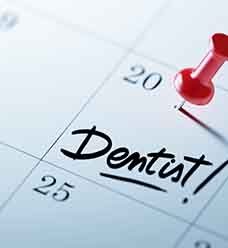
One common frustration that patients have with braces is that treatment involves more frequent and longer follow up appointments. Your provider must ensure all the equipment is in good condition, and sometimes things need to be replaced. New wires may need to be threaded, and various adjustments need to be made to ensure your teeth are moving as intended.
Invisalign requires fewer visits, and they tend to be shorter. Your orthodontic plan will be laid out in advance so our dentists will already have new aligners for you to switch to. Everything is already planned and created so your appointments shouldn’t take as long.

Studies show that people with dental problems are more likely to report feeling anxious, depressed, or less willing to engage socially with other people. When you’re overly concerned about the condition of your teeth, you might try to remain tight-lipped or avoid being near others.
With Invisalign, you start to see results faster than with braces. Often, you’ll start to notice changes within as few as 2 to 3 weeks. You’re more likely to look and feel like the best version of yourself when you know that improvement is already underway!

Adjusting to life with braces can be challenging because you have to make several adjustments to accommodate them. For example, you have a much more restricted diet that excludes anything overly hard, sticky, or sugary that could damage them. Plus, you have to learn how to eat and speak with them pressing against the insides of your mouth while trying not to lacerate the insides of your lips and cheeks.
Thankfully, Invisalign is considered non-invasive and doesn’t involve permanently bonding dental equipment to your teeth for the duration of treatment.

When it comes to fixing crooked teeth, Invisalign may be the recommended treatment option, but how much will it cost? These clear aligners might be what you prefer, but can you afford them? The good news is that no two cases will produce the same price tag. What you need may be vastly different than someone else, so the only way to determine your cost estimate is to schedule a consultation with our Jacksonville Dental Specialists team. You can also count on us to help maximize your dental insurance benefits so that you pay less when it comes to any out-of-pocket expenses you might incur.

As we touched on above, no two Invisalign cases are exactly the same. That’s why our team at Jacksonville Dental Specialists starts the entire treatment process with a comprehensive exam. Only then we can determine:
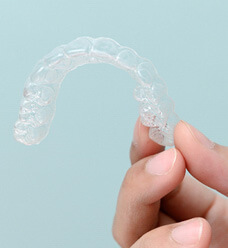
Have you seen advertisements for mail-in aligners? If so, you may have been tempted by the lower price tag and the fact that you can straighten your teeth from home. However, these orthodontic alternatives are not worth your money, no matter how cheap they are. Why? To start, they rely on DIY impressions, skip the initial consultation, and aren’t supervised by licensed dental professionals. Plus, they don’t have support from professional dental organizations, like the ADA.

Some dental plans do include a once-in-a-lifetime orthodontic benefit! So, it’s absolutely worth taking the time to read through your coverage to see if Invisalign is included. Of course, that’s sometimes easier said than done between the countless pages and unfamiliar jargon, which is why you’re more than welcome to reach out to our Jacksonville dental team with any questions – from if your plan includes orthodontic treatment to what your out-of-pocket expenses will be.
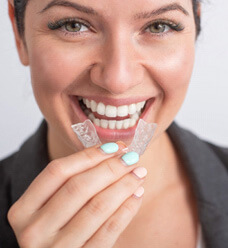
If you are interested in Invisalign but you don’t have dental insurance, you might assume that straightening your teeth is simply too expensive. That’s not necessarily the case because we offer another financial solution: CareCredit. This third-party financier offers payment plans so patients with all sorts of budgets can get the preventive, restorative, and cosmetic dental care they are interested in without the stress. Simply choose the one that works best with your monthly budget – it’s that simple!
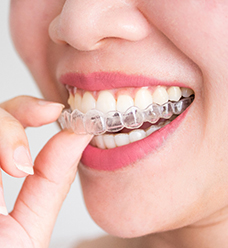
If you want to learn more about Invisalign – from the average treatment timeline to what happens after you’re done – you’re in the right place. In fact, we’re even addressing common myths about clear aligner treatment in this next section! So, don’t hesitate to read on to learn more about this discreet orthodontic treatment.
There is a popular rumor that Invisalign changes the way you speak. In reality, the large majority of patients with clear aligners have shared that that’s not the case. Plus, the small percentage that do only experience a minor change while their tongue adjusts to the presence of their trays. In other words, Invisalign wouldn’t be one of the most sought-after orthodontic treatments if it resulted in a lisp. So, don’t let that rumor stop you from discreetly straightening your teeth.
Invisalign can take anywhere from 6 months to 24+ months – it really depends! The complexity of your case, the number of aligners needed to straighten your teeth, and how well you follow the treatment guidelines are just a few of the many factors that impact your timeline. With that said, we will provide you with an estimate at your initial consultation as well as share all of our tips for staying on-track with your treatment plan.
Fortunately, Invisalign does not hurt. Of course, that doesn’t mean that you won’t experience some soreness from time to time. After all, your teeth are moving into completely new positions! For that reason, you can expect to feel some discomfort in the hours following your transition to a new aligner. It’s helpful during this time to stick to soft foods, sip on cool water, and take OTC pain medication as needed.
After your Invisalign treatment, our focus shifts from straightening your teeth to preserving the position of your teeth. That’s why we will provide you with a custom-made retainer! This orthodontic device plays a crucial role in preventing orthodontic relapse, which is the phenomenon where your teeth begin to drift back to their previously misaligned positions. For many patients, they only need to wear their retainer at night. However, we may ask that you wear it around the clock for the first few months if your teeth had trouble moving.
There is a common misconception that you can’t drink coffee with Invisalign. While you can’t drink this (or any other) dark-colored beverage with your aligners in, you’re welcome to enjoy it after you’ve removed them! We recommend drinking your coffee alongside a meal for that very reason; it will help you meet the 20-22 hour-a-day wear-time.
That depends! Usually, additional orthodontic accessories, like attachments, are used when the patient’s case of malocclusion is more moderate. The good news is that – even if you need 20 or more – they are just small pieces of tooth-colored resin. So, they won’t draw unwanted attention to your smile, especially compared to metal brackets and wires.
It’s possible, yes! In fact, many patients who have experienced orthodontic relapse in the years following their time with traditional braces have turned to Invisalign to straighten their teeth again. In other words, if you are interested in clear aligner treatment, don’t hesitate to schedule a consultation at our Jacksonville dental office! That way, we can review your dental history, take a look at the alignment of your teeth, and determine if you’re a good candidate for Invisalign.
Although Invisalign is quite versatile, it isn’t for everyone. For example, if you are struggling with severe misalignment, then traditional braces are needed to give you the results you desire. There are also some cases where patients aren’t a candidate initially because their teeth are decayed or their gums are infected. The good news is that we can usually incorporate the restorative care needed into their treatment plan, ensuring the final result is a smile that’s both healthy and beautiful.
First, let’s discuss what you should NOT do, like using superglue or moving onto the next set of aligners without consulting us. These may seem like simple solutions; however, superglue contains toxins that are not safe to ingest, and moving onto the next set of aligners in the series early can cause you to fall off-track with your treatment plan.
If you find yourself in this situation, we strongly recommend giving us a call. Once we know the extent of the damage and where you are in the teeth-straightening process, we can determine if we need to start the process of having replacement trays made or if you can safely move onto the next set of aligners in the series.
Good news: keeping your Invisalign aligners clean only requires a few products (and you likely already have them at home!). First, you need to use a damp, soft-bristled toothbrush and clear, mild dishwashing liquid to gently scrub the entire surface after each meal. Second, rinse your aligners with clean, cool water each time you take them off so saliva and other debris don’t harden on the surface. Third, soak your aligners in slightly warm water and the cleaning crystals to keep them stain and odor-free.